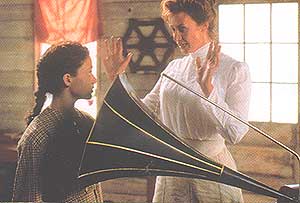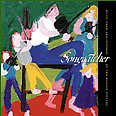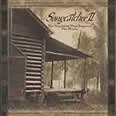For decades I have been going along, figuring that only my wife, some of my friends and I liked the quirky old stuff, sung by odd people with accents and idiosyncratic voices. We have been involved for many years in the performance of “living history,” and have been croaking out old songs for anyone who would listen (actually I have been croaking, my wife Sheila has a very nice voice) as part of public education programs, as well as for our own amusement. I have always been fascinated by music in its “natural” habitat, sung by interesting people in a style that was unique to them.
I knew there were a few others out there, though not enough to create much of a selection in Tower records. To feed our craving we had to make an annual pilgrimage to Down Home Music in Richmond, California, where we would drop a huge wad of cash for old-time music, sea shanties, Steeleye Span, Breton music, Scottish Border Ballads, or whatever else struck our fancy, and hope it was enough to hold us until the next year. O Brother, Where Art Thou? has suddenly made this stuff more or less mainstream, letting it out of the cabin on the lawn and in through the front door of the big house, making it noticeably easier to find “old-time music,” or “roots music,” or whatever it is they are calling it this week. What has not happened however, are any more old-time music movies. O Brother, Where Art Thou? and Songcatcher have their franchises going, and the recording industry seems to be paying a little more attention to the genre, but we are not riding the crest of a music revolution.
When Songcatcher came out last year, there was never any doubt that my wife and I would see it. We try to go to movies whose genre we approve, even if we aren’t sure we will actually like it. We figure that Hollywood money men are far too thick to tell the difference between a good film in a particular genre and a bad one. All they will see is that an old-time music movie pulled in a few bucks, so maybe they will make another one—and by some happy accident, it might be good. I went to Songcatcher with this sense of duty to the genre, not really expecting to love it. I had loved O Brother for its music and for its quirky Coen Brothers sensibility, which, while it appeals to me, is not everyone’s cup of tea. Unfortunately, the surprising success of O Brother and the minor art house success of Songcatcher has not led to a spate of copycat “roots music” movies. Our economic strategy has failed to have the desired effect on the movie industry.
This film has much to say about women’s empowerment and the preservation of disappearing traditions, making for a tolerable viewing experience. The earnestness of Songcatcher was, to me, a bit off-putting. The story was not gripping nor entirely engaging, but was not painful either. Like the dialogue in a kung fu movie, it made a bridge between the real pieces of meat in the film. In a kung fu movie, improbable fight scenes with crude sound effects give the movie its anchor and its charm. In Songcatcher it is musical performances.
When the camera settles on some weathered face and the music begins, the movie slows to a halt, and that’s just fine with me. Iris Dement sitting with her greasy hair and dirty mountain schmata on a rocking chair on the porch of a cabin, singing “Pretty Saro”—an old and melancholy ballad—was a high point of the movie for me. However, the set-up to Iris’s one and only scene was a bit contrived. She and her husband had, as the scene opened, been forced to sell their farm at a loss to the film’s villain, who is acquiring land for the mining companies. However, despite having just that instant lost everything they had in the world, they take the time to sing a song for the heroine. The scene, though contrived, had tremendous impact on this viewer. It was a bit of shameless emotional manipulation, which at least on me, worked pretty well. More than anything else in the film, this scene advanced the central premise: in the Mountains, music was as natural and integral to life as breathing, eating, drinking, laughing and weeping.

I suppose, having jumped ahead to the best bits, I should say something about the rest of the movie: it is a work of fiction “inspired,” as the movie folk say, “by real events.” It follows the adventures of a female musicologist (played by Janet McTeer) some time around 1910, who leaves her university teaching job and married lover after being passed over by her insensitive male chauvinist bosses for a promotion (to which one might interject—it’s 1910, lady—what did you expect?). She flees to the Appalachians of North Carolina to hide from the world with her sister, a crusading school marm and closet lesbian who is trying to educate the mountain people. McTeer’s character immediately realizes, after hearing the girl who helps out around the school singing that old British standard “Barbara Allen,” that the mountain people are a priceless treasury of an unbroken folk tradition. She then launches a campaign to document and record the mountain musical tradition. This leads to various adventures, encounters with colorful characters, love with the character played by Aidan Quinn, and (here’s the important part) a fair amount of very fine traditional music.
There is an important difference between this movie and O Brother, Where Art Thou? in the music. The same earnestness that infuses Songcatcher’s story also leads to a very simple, “authentic,” and in some ways more scholarly presentation of the music, as performed by excellent musicians like Iris Dement, Taj Mahal, Don Pedi, Sheila Kay Adams, Josh Goforth, including a tag-team performance of “Conversation with Death” by David Patrick Kelley, Bobby McMillan and Hazel Dickens.
Much of this, though alas not all, is available on the soundtrack CD. Being a soundtrack, it had to include the orchestral bits composed by David Mansfield (the director’s husband) and only a few of the pieces I remembered and liked from the movie. Furthermore, to fill it out, they added songs “in the spirit of” by artists like Dolly Parton. The orchestral bits and modern songs are not bad, but also are not what I feel like listening to when I pop an old-time music CD in my machine.

Worst of all, the young woman who played the-girl-who-helps-out-around-the-school, Emmy Rossum—who has a wonderful voice for acapella music—was excluded from the soundtrack CD with the exception of a brief lead in Emmy Lou Harris’s modern rendition of “Barbara Allen.” I had looked forward to hearing her tackle an entire song on the CD, since she was invariably interrupted in the movie just as she got rolling. I was disappointed. I can only suppose that the limited budget of the Songcatcher producers or other logistical problems made it unfeasible to pile all the traditional musicians who appearedon screen into a studio to do full renditions of the pieces they only did parts of in the film. I also suppose that the producers felt like a soundtrack must document the music of the film, and since the film included some orchestral tracks, they too must appear on the CD. One might also conclude that with the composer being married to the director, it would be pretty unlikely that his work would be absent from the soundtrack CD. Then, I guess, after putting together the few complete traditional tracks, the modern rendition of “Barbara Allen,” and the orchestral tracks, they realized that they didn’t have enough to fill a CD, so they asked Dolly Parton and others to whip up a few more pieces.
Which brings me to the recently released Songcatcher DVD: the DVD includes, in addition to the film itself, an interesting collection of extras. One of them is a feature that I generally find tedious and self-indulgent, but which was very interesting on this film. It was the “commentary” section with the director Maggie Greenwald and her composer husband David Mansfield talking while the film is running. While I wouldn’t suggest having this feature turned on the first time you view the film, the background on the performers, and the interesting and quite frank historical comments (like) “there were no female musicologists teaching at men’s colleges in 1910” or “Jean Ritchie popularized the dulcimer for American music in the 1950s, and you wouldn’t really have seen one in the mountains” were quite informative and often amusing—if only for the confessions about their deliberate bending of history for theatrical purposes. Other special features include the extended performances by Iris Dement singing “Pretty Saro,” Taj Mahal doing some fancy banjo picking, and an extended and very chilling rendition of “Conversation with Death,” with some seldom performed verses about the torments of Hell and the fact that it’s too late to repent when Death is at hand.
To balance out these interesting and informative features, they have included the requisite collection of useless crap DVD features. The foremost of these is the “music track only” feature, which deletes the dialogue and sound effects tracks and has nothing but the orchestral score and instrumental backgrounds. Included in the missing dialogue track are all the on-screen vocal performances, so you hear nothing but silence when Emmy Rossum is singing “Barbara Allen,” and all you hear is fiddle when Iris Dement is singing. It’s a bit surreal, and of probable interest to no one but the film student who wants to see the integration of a musical score without the distraction of dialogue. Unfortunately, while the orchestral score is competent, it is not particularly remarkable, and a discussion of it would not provide much grist for a graduate student’s dissertation mill. After having heard the detailed commentary track, the interview section seems a bit thin, and the interviews with Aidan Quinn and Janet McTeer were particularly fluffy and could just as well have been on Entertainment Tonight.
The sum of all this, and the sum of the movie, is that it really is about the music. The film is a vehicle to present traditional mountain music in an approximation of its proper context, and when it focuses on that, the film and its DVD succeed. It would have been a better movie for me if it had crammed in a little more music, and spent a little less time on exposition, but then that might just be my prejudices showing.
A logical extension of CDs that focus on modern performances of traditional music is to produce CDs containing original recordings of the songs that inspired the movies. Both the O Brother franchise and the Songcatcher folks have done this, and both CDs are worth a listen. The most recent O Brother CD is titled O Brother: The Story Continues. The CD contains twenty-four tracks, most of which date from the 30s to the 50s. It includes two versions of “Man of Constant Sorrow” and two more of that massive mega hit “Oh Death/Conversation with Death” that won Ralph Stanley a Grammy. The exception to the original recording format for O Brother: The Story Continues are the recent recordings of Negro spirituals.

“Conversation With Death” also makes an appearance on the Songcatcher follow-up Songcatcher II: The Tradition That Inspired the Movie. This CD contains seventeen tracks, most of which are performed by Doc Watson or Almeda Riddle, with a few by Dock Boggs and others. It also includes one of my favorites: “Babes in the Woods,” a wonderful example of saccharine and maudlin Victorian sentimental drivel infecting the folk tradition. [Listen to different versions of “O Death”]
One should also mention the original O Brother, Where Art Thou? soundtrack CD, which, unlike the Songcatcher soundtrack, is entirely uncontaminated with orchestral music. Even pieces like “Go to Sleep Little Baby,” which were written for the movie, fit in nicely with the other songs. My only gripe with the O Brother CD is the screen saver feature that is available if you happen to put it in your computer. It murdered my employer’s Windows 98 machine entirely, and took me quite some time to repair and uninstall.
To round out the movie-related materials, one must of course include the “Down From the Mountain” concert tour, CD and video from our O Brother friends. The concert came to Southern California early last year, and was about as good as it gets, with the Fairfield Four, Alison Kraus, Emmylou Harris, Ralph Stanley, others too numerous to mention, and special surprise appearances by Taj Mahal and Tim Blake Nelson (dumb-as-a-bag-of-hammers Delmer from the movie). The live CD is good too, as is the video; but all are a pale reflection of the experience of the folk music all-star show that was the live performance. This is a show that would never have happened were it not for the surprising success of that goofy Coen Brothers film.
With these films, disks, and videos coming out, there seems to be something very interesting going on. The greater availability of music from the Middle East, Latin America, and Asia (a.k.a. “World Music”) points to a growing interest in alternative musical forms, most of which are devoid of high-tech recording techniques, audio wizardry and “sampling.” This has been accompanied by a partial rejection by the rock mainstream of the electronically overproduced in programs like “MTV Unplugged.” I say “partial rejection” since those same artists who appear one night with their acoustic guitar on the same stage with a hurdy-gurdy will be in the studio the next day, being electronically enhanced.
The mainstream will always favor the slick and highly produced, and will embrace every new technological gimmick. It will also tend to favor the formulaic and annoying, presented by almost indistinguishable performers (is it just me, or does anyone else need a score card to distinguish between Christina Aguilera and Britney Spears?). However, we old curmudgeons can take some solace in the greater availability of our kind of music, and the fragmented media market of our times makes it very easy to tune out *NSYNC and listen to something more congenial. Something that has an unbroken connection to the entire history of a people and something that has a human face, soul and voice; and something I can sing along with or take a partner in my arms and dance to.
Next Essay (insert link to Seeger article)
Discography
Before the Blues: The Early American Black Music Scene as Captured on Classic Recordings From the 1920s and 30s. Yazoo, 1996.
Brown, Mason & Chipper Thompson. Am I Born to Die: An Appalachian Song Book. Dorian, 2001.
Down From the Mountain: Live Concert Performances by the Artists from O Brother Where Art Thou. Lost Highway, 2001.
O Brother, Where Art Thou? Mercury, 2000.
O Brother: The Story Continues … . Lost Highway, 2002.
Songcatcher: Music from and Inspired by the Motion Picture. Vanguard, 2001.
Songcatcher II: The Tradition that Inspired the Movie. Vanguard, 2002.
